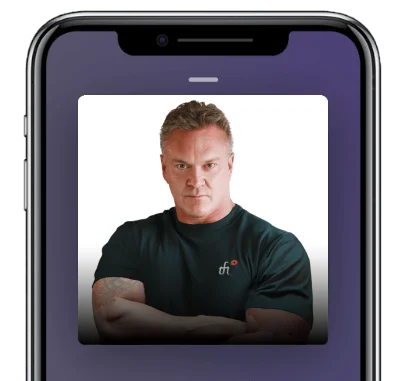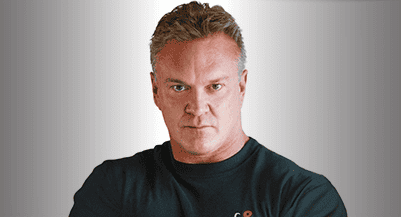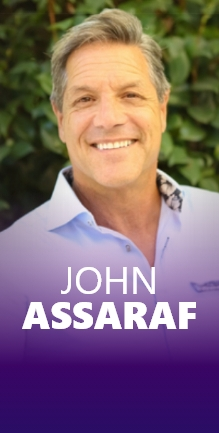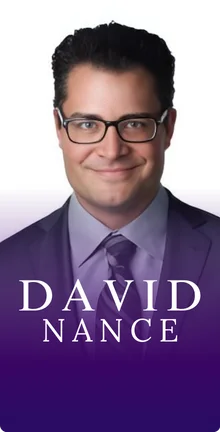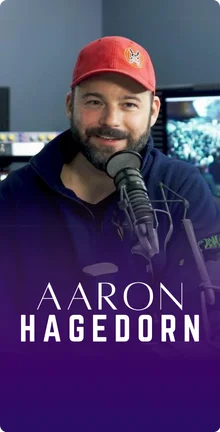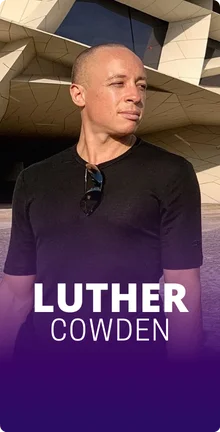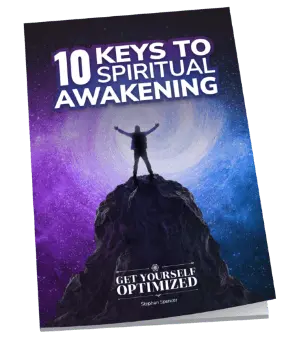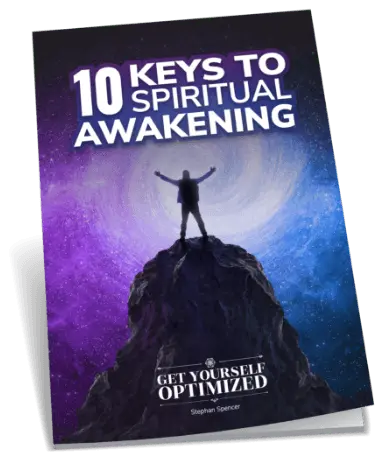In this Episode
- [00:39]Stephan introduces Tim Larkin, a self-defense expert, founder of Target Focus Training, and author of the New York Times bestselling book Surviving The Unthinkable.
- [06:19]Tim shares how he and his brother used to play in the SEALs team obstacle when he was just 13 years old.
- [12:30]Tim explains how the brain and body can make a human dangerous.
- [18:44]Tim tells a riveting story about how one of his students was able to protect themselves from being attacked by a group of men in a parking lot at the hospital in Ohio.
- [24:28]Tim shares one of his female clients’ experience, who only had two days of training with him, saving her life from a man who tried to attack her.
- [30:25]Tim elaborates on the topic of using violence only when you’re devoid of choice.
- [35:20]Stephan and Tim discuss situational awareness to avoid potential violence and danger.
- [41:25]Tim tells a story of where a woman recognized asocial violence from a man she saw in her university parking lot.
- [47:52]Stephan recalls a self-defense technique that Tim taught on protecting yourself if somebody is trying to grab a gun from your hand.
- [56:13]Visit Tim Larkin’s website at SurviveViolence.com to learn more about how to eliminate your attackers’ threats.
Welcome to the show, Tim.
Hey, it’s great to have you. Thanks so much for having me, Stephan. I appreciate it. I appreciate the persistence too. Finally got this happening.
Absolutely. You’re worth it. I’m so excited for us to go into some of these important topics around self-defense. First of all, what inspired you to get into this field in the first place?
I was a Navy brat so I lived on Navy bases during my school years. Originally, probably the first encouragement I got was from my grandfather. He was from Boston and he believed every boy needed to learn how to protect themselves. Very early on, he taught us boxing. He loved the sport of boxing. What was interesting though, the one thing that was seminal in that was probably I couldn’t have been more than six years old. He had us down the basement – he had a big house in Boston. The basement was where we went down to learn how to box. My cousins and I were down there and he would tell us all the time, “Okay boys, this is what you do in the ring and this is how you go.” And then he’d stop and he’d point to the basement window that went out to the street, and he’d say, “Listen, boys. In the ring, there are rules, and you abide by the rules, and you do your best and all of that.” But then when he points out the window and he’d say, “But if anybody out there tries to hurt you, don’t play by the rules. You need to protect yourself.” And then he showed us things that were completely different than the competition training with boxing. He would show us real injury to the human body.
I remember the first thing that I learned, and again, I was six years old. I don’t think my mom had any idea what my grandfather was teaching us. But one of the first strikes he ever showed us that had a real injury behind it was a strike to the bladder. If you go where your belly button is, and you go down about two to three inches, that’s basically where your bladder resides. The reason he taught us that was because he said, ”Men always try to protect their groins. When they try to protect their groin, they highlight the bladder, and the bladder is a much easier strike for you.” And at the time I was like, “Okay, what are you talking about?” But years later, what I realized was my grandfather had to protect himself. He came from a very rough Irish background and he understood that once we are outside, it can get really bad very quickly for somebody who doesn’t understand how to use violence. He had been around people that understood how to use violence. He was the one that connected areas of the human body that can’t be protected. He taught me the basics of the injury of the human body and the response to injury and that was my first introduction to that.
Without your brain and body correctly trained, you're not as effective as you think you are. Share on XAnd then, being a Navy kid, my dad was an officer in the Navy so we moved all around and I did a ton of martial arts and boxing at all the bases. Most of the bases would be the Marine Corps. The Marines would run programs for kids. Programs like if we went to the gym, they taught us to box, they taught us to wrestle, they taught us judo. It was cool. It was great growing up. My grandfather was the first one that taught me injury and the human body. And then going into my years as a young kid, I was exposed to this very early on. I’m in my early 50s and so my generation, it was kind of acceptable. You’re expected to be able to fight. I went to an all-boys Catholic High School and if you had a problem with somebody, you were encouraged to get in with them in a boxing ring, and you worked it out. So we were very comfortable with the idea of violence, not to be violent, but that there was a time and a place for it. Sometimes it can be a very healthy outlet if you did martial arts or sports, or sometimes it can be detrimental if it was used criminally. For some reason early on, that became something that I was exposed to, and of course, being a needy kid, one of the last places I ended up was the–we lived literally in-court on an island and maybe housing. Right across the street, my backyard, looked at a small highway, called the Silver Strand highway. And right across there with a wire covered chain link fence was the SEAL command. That was where the very famous obstacle course, for buds training, it was right there.
Martial arts is a very healthy outlet but sometimes can be detrimental if used criminally.
As a young kid, I think I was like 13 years old when I first jumped the fence. My brother and I jumped the fence, and we started playing on the obstacle course, because we had no idea what SEALs were, we had no idea what this was, we just knew there were these crazy guys that would get the jump out of airplanes and blow things up. We couldn’t believe that was a real job. So I started hanging out with these guys called the SEALs as a young kid. They thought at first we were annoying to them, and then they realized we weren’t going anywhere. And that they figured they just let us hang out. They started to educate us on what was what. So I learned everything, and this isn’t in the late 70s, early 80s. I learned everything there was to know about SEAL training back then. Back then it wasn’t popular. Nobody knew who the SEALs were. It’s not like it is today. I was very impressed with that, so my only goal when I was 13 was I wanted to be in the SEAL’s teams. And my father who is a Navy officer, who wasn’t a SEAL, he was in the regular Navy, he thought it was a passing fantasy. And he said, “Okay, but let’s go to school first. I want you to get your degree.” So I got an ROTC scholarship. I went to USC, but all I wanted to do is be on the SEAL teams. And what was interesting was back then it was highly discouraged because the SEALs back then under the Cold War weren’t as active, they weren’t as important as the nuclear assets. Like other parts of the Navy were far more prestigious. You were treated almost like the redheaded stepchild if you went into SEAL teams at that point. So I got exposed to that and I got into that.
Now, I had all these martial arts and combat sports background before I got into the SEAL teams. And my grandfather taught me injury in the human body and I didn’t realize how many injuries the human body can play in my life. And to give you the very short version, I was overly qualified and ready for my field training when I got it. I got two slots, there are two slots available. I got one or two slots, 2500 guys went for it in the officer corps. And I got one of those two slots. I used that to my advantage, all that knowledge that I had to get through training. I was flying through, I was the number one guy. I was arrogant about it, I was weeks away from finishing the training and going to SEAL team four back. I’d already been assigned my team, I was going to go to. We had a very basic dive one day, and I was congested, and I forced myself to dive because I didn’t want to do a makeup dive later in the week. And I ended up blowing my eardrums, and if anybody’s ever had that happen, when you blow your eardrums, you have a sensation called vertigo. And it’s where you lose all sense of balance at that point. I was in the peak of my conditioning at that point, and yet, this was my first real introduction to injury to the human body. I had no control over my body, I couldn’t will my way out of it. I couldn’t do anything. Of course, it ended my career in the SEAL teams before I even started.
It was fascinating to learn how to train people how to protect themselves.
Now they kept me in the community, not as a SEAL. But they sent me to the intelligence school and I became a Special Warfare intelligence person, which was very interesting. I had an incredible job. I was a very junior guy and a very senior command, I got to work with everybody in the community. But what was interesting was that command back then the Berlin Wall had come down, Cold War was over, and the SEALs that I was at this command with, the admiral ran, he ran it for all the SEAL teams, it was Naval Special Warfare Command, it was a brand new command. We were the first plank, it was called a plankowner, a new command is created and you’re on it. I was a plankowner there. And I was with the legends of the SEAL teams, I had no business being there. They gave me the intel slot because of my background, and they liked me. But I had no combat experience or anything like that. But yet I was surrounded by the guys who were just “the guys” back then. They first saw everything that’s happening right now, basically the wars that we’re in now. They saw how Bosnia and Herzegovina were going to happen. And they realized that their method of training for the Cold War now had to be replaced for these tribal wars, these house to house wars, were gonna put hands on people again. They realized that the hand to hand combat training had been kind of set aside for the last 20 years since Vietnam. And they started looking at it again. And I was invited to be part of the pilot program, only because I was a young guy, and I had a martial arts background. And these guys like me, not because of any other reason. I had no business being in there. But they thought it would be good for me to be part of it. That is really where target focus training started.
Because what was interesting was the individual, and I ended up finding this guy randomly and bringing him in. I mean, it was dumb luck that I found this guy. But the guy that we brought in to help us taught us how to exploit all the weak areas of the human body combat sense. It was fascinating to learn how to train any human being to protect themselves. The interesting part was it was like a great equalizer because the areas of the human body that we’re talking about, and we know some of them, like the throat, the eyes, those are pretty normal. But as I talked about the bladder, there are approximately 120 areas in the human body that cannot take trauma, meaning no matter how much we work out, we can’t protect these areas. And this guy was a former Vietnam vet and he understood, not as an academic, he certainly wasn’t an academic at all. He’s very much self-taught but he was brilliant. He could see arcs and angles that other people couldn’t see. And he answered questions that weren’t just dealing with, say hand to hand combat or say like, fighting in a ring. You could tell him, “Hey, we carry this type of equipment. We’ll have this type of kit, this type of a backpack on. This is the rifle that I carry,” and he could synergistically make all that stuff work because when you understand how the body responds to trauma, you understand that what makes a human being dangerous is an act of brain.
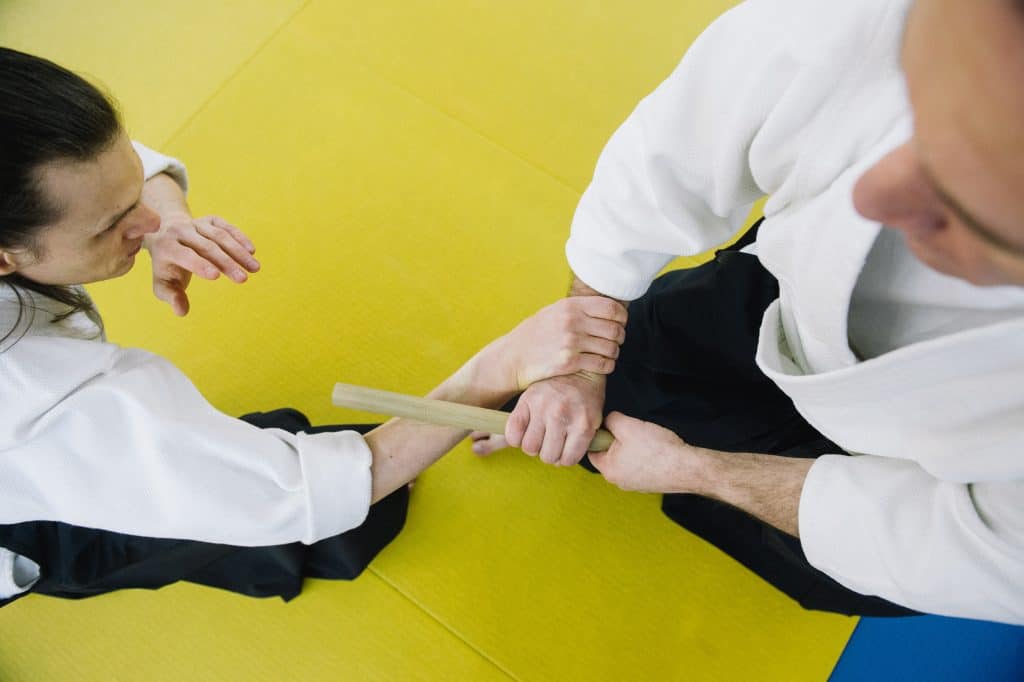
Your first tools available to you are your body tools. And that when you train somebody male or female how to use their brain and body to protect themselves, in this universal sense, everybody’s equal. It’s really interesting; you have people that are much smaller able to injure much larger people because they’re not trying to compete with strength, they’re not trying to compete with athleticism. They’re going directly to the human body that can’t take trauma. If you know how to exploit that, you can save your own life. Now, I thought it was only going to stay in the special operations community. I thought that what we were learning was far too extreme, to be talking to civilians.
So pretty much I stayed in for a couple of years. And then, right after Gulf War One, there wasn’t much during the military. And everybody was getting out. And so I started doing contract work. We’re doing Blackwater type work before Blackwater existed, I was working mostly in South America and Venezuela. And we were training all sorts of foreign military, foreign law enforcement, and we’re all doing it through the State Department to do that. It was fascinating during those years, to be training like that, especially working with the counter-narcotics stuff down there. If anybody here has watched the Netflix series, Narcos, those are the years that I was working down there with everything that was going on during that time. And it was interesting how those skill sets of using your brain, your body, were far more important than learning how to use a lot of the tools, a lot of the weapons and stuff like that. Because without your brain and body correctly trained, you’re not as effective as you think you are, with these tools. Because if I don’t have the gun on me, or if I don’t have the knife on me, I feel like I can’t protect myself. What we’re really big on is the idea of training your brain correctly, first on how to look at violence, and then coordinating your body tools to be able to affect injuries on another human being.
What you realize is that speed actually can end up being your enemy.
What you experienced in our training was the basic foundation that we put in and you talked about the slow deliver training that we’re learning, that’s the baseline that you use for everybody, and it’s counterintuitive. Most people think when you train violence or you train to protect yourself for self-defense, everybody sees it as having to be ballistic and full speed, and just completely focused on hard and fast. What you realize is that speed actually can end up being your enemy, if you don’t lay a good foundation. So what’s interesting is I can train some of the most unlikely people to be very proficient at protecting themselves using methodologies that cause most people to scratch their heads. The slow deliver training, like you’re talking about. And the reason being is because most of us think of hand to hand combat or anything like that as some sort of competition. We go to like the UFC, or any of the combat sports events that we see. And oftentimes, that gives regular people an excuse not to train because they’ll look at these amazing athletes, who are just incredible, doing incredible things in the octagon, or the ring, saying, “Well, I could never do that. So it’s not worth it for me to even train.” And nothing could be further from the truth. Because the reason people can create contests like the UFC, or any of the combat sport contests, is because we’re able to gamify violence. And the only way you can gamify violence is to take out direct injury to the human body. So the last time I looked at the rules of the UFC, there were 31 rules. 27 of those rules prohibited direct injury to the human body. So it’s kind of like that idea if you just flip things on end you’d say, “Well, gee, if I didn’t want to deal with bigger, faster, stronger, and somebody who’s much more athletic than me, how could I bypass that?” Well, it looks like what the rules tell me to go right to direct injury to the human body, and all of a sudden, no matter how big, fast, and strong this individual is, if I’m successful in injuring them, they’re gonna have to focus on their injury. And that’s the disconnect that most people don’t understand.
What I found interesting was that training civilians is more rewarding to me than training the military and law enforcement.
Most people tend to see a competitive sport like Brazilian Jiu-Jitsu, or any of the great combat sports that we have. And they equate that with being able to protect themselves. That’s not true when it comes to the stuff that we’re concerned about, which is like criminal violence, or any of the things that you saw in the summer where people are being pulled out of the cars, and some of the different violence that we saw during the pandemic. You saw people having to deal with real situations. You also saw people deal with them poorly, you saw people who weren’t equipped to protect themselves try to protect themselves and went wrong because they didn’t understand how to navigate violence. To me, that is the most incredible thing is I’m able to use this highly specialized military training that we did. It was designed for special operations personnel to immobilize any threat right off. I’m able to give it to civilians, in a very sober, straightforward manner. Whereas most people wouldn’t say they wouldn’t see how you could train civilians, what the need would ever be for them to have information like this. What I found interesting was that training civilians is more rewarding to me than training the military and law enforcement. I love training the military and law enforcement guys, it’s great, but I expect them to do well. They also don’t operate alone oftentimes. They’re usually with their team, and they have tactics and they have the equipment.
The one thing that got me was after I started training some of the civilians after 911. I had a doctor reach out to me, he was in the inner city. I think it was in Cincinnati, Ohio. He went to an inner-city hospital to perform a brain surgery on a young kid that had a swollen brain, and the child was dying. He goes to park his car, he had a nice car, he parked in the parking lot at the hospital. He immediately was attacked when he got out. There were guys waiting there trying to grab it. Here’s this doctor going to save this kid’s life. They come at him with a knife, he sees an opportunity to put an injury on somebody, he immediately does that injury. He takes the first guy out, the second guy sees what he did and takes off running. He just takes off running because they didn’t expect any resistance. Security sees it on the camera, they come in, they take over and arrest the guy as the doctor goes and performs surgery that saved the kid’s life. And the first thing he did was he came out, he washed up and he wrote us right away what he experienced. And when I got that, that’s when I realized I said, “Okay this never should have happened to this doctor that is going to save a kid’s life.” And yet it did. And he was able to protect himself because he took a two-day course with me, which people say you can’t learn anything in two days. I agree if you’re trying to be a world-class, UFC fighter for two days, it’s not going to do it. If you want to learn how to use violence to protect yourself, the tool of violence, it‘s a very easy straightforward skill set and you can learn a lot in two days.
The idea of self-defense is never to inflict or initiate violence. It must be used for protection and protection only. Share on XRight. It was in 2012 when I took your training in Cabo. I remember learning about reaction partners, going slow-motion, and punching somebody in the neck, popping their eardrums by making like a cut and coming at them from both sides. I remember scooping out their eyeballs as if it’s like a little cocktail glass, going after the knee and the ankle if you can get to leverage in just breaking their bone in half. I haven’t practiced any of that. That was eight years ago, and I still remember those. I could pull one of those if I needed to or if I were in a life-threatening situation.
That’s by design, you were taught principles, and so this is one of the big things like a lot of people when they look at self-defense, or any sort of martial arts training a lot of that is technique based. So you learn techniques. But what you learned was areas of the human body that don’t change. They’re in here and the approach that we took because we went slow and deliberate, and there’s a kinesthetic portion of it, where you’re touching and pushing through these areas, it’s just a learning methodology that’s superior, and you retain your retention is quite surprising. I’ve had people like yourself, they trained with me years ago, something happens. And then that one part of the human body just shows up to now in the incident. They see whatever the predator avails them to, maybe by pulling them in close, maybe it’s the throat, maybe it’s the ear, maybe it’s the groin. And they understand what to do with it.
I have clients attacked by bigger, faster, stronger people, and they knew what to do to save their life.
When I train a client, I could not train them, throw them in a ring with a very accomplished fighter, and not understand the outcome is going to be horrible for the person I just trained. Because they’re training under those rules, those conditions in that situation, that’s not what I’m talking about. What I’m talking about is a predator who does not fear you, gives you an opportunity, pulls you in close, they don’t injure you, you can still think and move. And you now know how to exploit that one area of their human body to put an injury on them, and then you see another area, and then you keep putting injury on them until they’re no longer a threat. They’re non-functional to you. What’s interesting about that is the surprise factor, they can protect themselves in ways that you’d never think possible. I have numerous examples of my clients attacked by bigger, faster, stronger people who did not fear them but gave them an opportunity to exploit, and my client knew what to do, and they’re able to save their life.
Yeah, so it’s like, the perpetrator or the attacker, is using the element of surprise oftentimes, to try and get your car or break into your home or whatever. But then you’re using the element of surprise when they’re not expecting it with your skilled reaction and causing injury to that.
Yeah, I’ll give you a perfect example. I had one woman that went through my training, and it was rough for her. She had been attacked before, and her husband brought her to the training. She had a therapy dog, it was a German Shepherd, but it was still a therapy dog. There were times where she had to get off the training area and just breathe because she was reliving some of her PTSD from the attacks. Especially when the knives came out because she was taken at knifepoint before. The interesting thing is, and I tell every class, I’m sure I told your class the same thing. Statistically, I don’t know who it’s going to be in the room, but somebody is going to have to use the information. It’s just that’s how it always works out. And it’s never who I think might have to use it. Like the people that are like, maybe the military guys or the law enforcement guys, I think I’m going to hear from them. Sometimes I do hear from them but what I end up usually hearing is from an unlikely person or a person like her. I remember talking to one of my instructors, and we both said, “I just hope she gets a pass the rest of her life. She’s a good person. She made it through training, but this was rough for her.” She had to relieve a lot of tough things.
Sure enough, I think it was about six to eight months later. I heard from her husband and sent the police report. She was at a Home Depot, and she had bought some flowers that she was going to plant, and she put her dog into the kennel that she had in the car. She kenneled her dog, and she started taking the pots of flowers put in the back of her car. She wasn’t paying attention, at one point she heard somebody behind her say, “Can I help you?” And the nonverbal just kicked in, and she felt the hair in the back of her neck go, she goes, it’s happening again. Sure enough, just as she’s thinking that this guy scooped her up and he starts trying to take her away. What she realized was she could still carry, but she realized she couldn’t get to her gun. And she goes, I heard if it’s not in your hand. It’s not your primary weapon. I mean, this is somebody who literally had two days of training with us and had experienced violence before. And she said, “Oh, I can’t get my gun, but my elbow is free. And I know I can turn it back into the sky and strike him in the neck.” She understood that that was a viable target: the side of the neck.
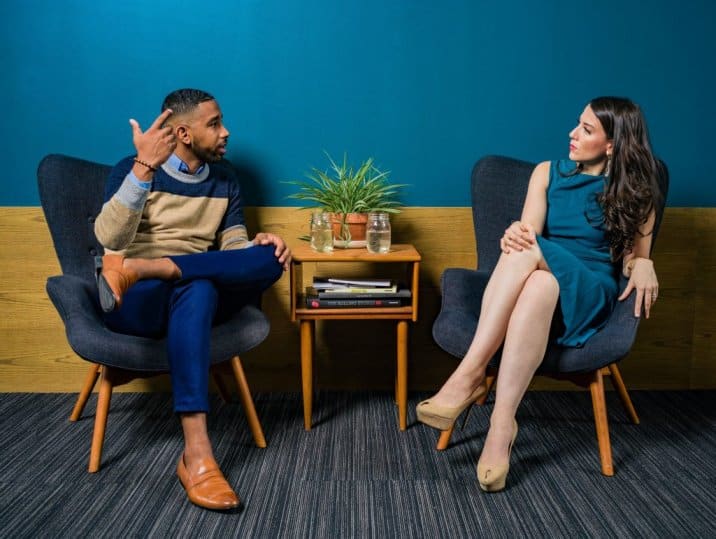
The side of the neck has a vein and artery, and two nerves. And when you strike it, you can create two things, if you hit hard, you can create a concussion, or you can cause the person to faint from a vasovagal response. All that means is you interrupt blood flow, and all the blood drains out of the head to the brain to protect the body, and it puts you to sleep. So either one of those results is good for you. And sure enough, she just threw all of her weight into a twisting and hitting this kind of side of neck, and he let go of her as he started to kind of fall and faint. And then she saw his knee, and she stomped on his knee, which ended up breaking the knee cartilage and the guy is on the ground, he hit his head on the ground, he was dazed, he came back up grabbing his knee screaming. What was funny with people then from the parking lot all started to come around, they started to see what was going on. He pointed at the woman and said she attacked me. And she heard that comment and goes, “Well, it’s kind of true. I did.” But she saved her own life. And of course, when the police came, they asked her, they said, “Well, you had a gun on you, why didn’t you shoot? You would have been well within your rights, even after striking him and knocking on the ground. Just shoot him to make sure that he didn’t get back up.” This guy has a rap sheet a mile long. Sure enough, he had the panel van. He had the line, and he was going to take her to a secondary area, either sexual assault or just kill her. That was this guy’s MO. And they played all that in the cameras.
Real violence is something that you survive, and you never want to experience again.
But what was interesting was, here’s this woman, who’d experienced violence before really, who didn’t think of herself and anybody could take care of herself. But because she had principles and methods that she didn’t have to memorize and that she just had knowledge of, she was able to protect herself in one of the most unlikely circumstances. It’s real people like that that excite me when I reach those people. Because so many of us have sold a bill of goods, saying that if you’re not a world-class athlete, you somehow can’t protect yourself. If you’re not bigger, faster, stronger, you can’t protect yourself. And really, that’s not it, that makes us all dangerous. As I said in the beginning, it is the human brain. The human brain is something that sets us apart from the rest of the species. And it allows us. We’re not the biggest, fastest, and strongest. If we had to be the biggest, fastest, and strongest to be the primary species, it wouldn’t be us. I tell people all the time, “I’ll get a ten by ten cage, I’ll get a 65-pound mountain lion that hasn’t eaten in two days. And who wants to jump in the cage with it?” And nobody wants to do that. Animals that have much faster reflexes are far stronger than us. They’re far more lethal with their body tools.
But the reason we are more dangerous is because of our brains, and we’re able to hunt in packs. We understand how to do all that. It’s the same thing when it comes to your self-protection and what’s interesting is, unfortunately, I gave you a story of two people, the doctor and this lady that had to use the information. What’s rewarding is, why is it worth studying this stuff? I’m sure some of your people might be listening to this going, “Yeah, I don’t know, why would I ever need this?” What most people get out of my training is they start to have a situational awareness that they didn’t have before. Because once you understand violence, once you understand what it takes, what you’d have to do to another human being to protect yourself, none of us want that, nobody wants to participate in violence, you don’t. And the way I try to convey that to everybody is usually in the class, and I might have done it with your class. I’ll ask everybody, “Hey, how many people here know how to swim?” And everybody will put their hand up, and most people know how to swim.
Except for me. I don’t know.
When you’re facing imminent serious bodily harm, you have no escape and no way to talk your way out of it. That’s when violence is necessary.
And then I’ll say to those people, “Okay. Of those that know how to swim. How many of you have ever had to swim for your life?” And a much less number of people, but I will keep my hand up because I’ve had some for my life a couple of times. And then I’ll say, “Of all those people that had to swim for your life. How many of you would ever want to experience that again?” And all the hands come down because they survived it. It’s nothing they want to do. That’s what real violence is. Real violence is something that you survive, and you never want to experience it again. If you hear people bragging about, “Oh, I kick this guy’s butt,” they chose to use violence in a situation where it wasn’t imminent, you weren’t devoid of choice. What my clients understand is, if there’s a choice involved, the answer is always no. I mean, if I can leave, I leave. If I can talk my way out of it, I talk my way out of it. It’s only when you’re devoid of choice when you’re facing imminent grievous bodily harm, you have no escape, you have no way to talk your way out of it, you could have exited, that’s when the tool of violence is necessary to use. That’s when you need this kind of knowledge.
But what’s interesting is, the more people trained in this subject, and I get this from some of the most unlikely people, they tell me all the time, they go, “Wow, if the old me would have experienced this situation that I experienced today, this way, and I probably would have done something stupid, that would have given the potential for me to get into violence situation because I was ignorant, I didn’t know. But after understanding violence and training how to do this, I understood to get out of there right away and just leave. And even if my ego is damaged, that’s fine. My ego can be damaged and call me names, I can do whatever, but I got myself out of there.” What’s fascinating is all the things people think about after training that they need to change in their lives. And I call that the idea of how many of you are sleeping with your head on a railroad track and thinking you’re okay because the train didn’t come last night. And my only goal with everybody is, “Hey, take your head off the railroad track, and then you don’t have to worry about the train.” It doesn’t matter if the train comes because you’re not in the way, and that analogy hits people. Because they start seeing, “Wow, I was taking all these unnecessary risks.”
When people are trained to use their brains and bodies to protect themselves, they get a fair advantage in any given situation. Share on XMeaning something simple like it’s 10 p.m., and I decide to go to the ATM. But I got away with it, so no big deal, right? I show people videos of people going to the ATM after dark, precipitously after eight-thirty attacks at the ATM are huge. I showed this one picture, this one scenario, I have an older couple. They get viciously attacked. I even ask people in my world, other professionals, to evaluate the video, and everybody says, “Oh, well, it was of an older couple. The wife goes to the ATM and the man, they’re both looking at the ATM.” And people are saying, “Well, he should have been looking out towards the parking lot and what she’s doing,” and they come up with all these tactical scenarios of what people should have done. Nobody looked at the timestamp. So then I have everybody look at the timestamp. The timestamp was ten thirty-five at night. And I said, “How many times do you think they’ve done this? How many times do you think they have gone to the ATM after dark thinking it’s no big deal. And almost it’s their right to do that.” But what was so important, they had to get their money that night at that time, and they could have woken up in the morning, 20 minutes earlier, to go to the ATM during the day where the risk is just next to nothing for these types of events to happen. And that’s what I’m talking about. People get so surprised when I talk about prevention like that. They think,” Oh, no, you’re the guy that wants to always use violence on people and stuff.” No, I’m the last person that wants you to have to use the tool of violence because I understand what that means.
The more highly trained somebody is with new lethal applications of violence, the more peaceful their life is.
But what’s interesting is that the more highly trained somebody is with new lethal applications of the use of violence, the more peaceful their life is. Because they understand, they make better decisions. They don’t take the bait. They don’t get involved or triggered by events that other people get involved in. And I’ll give you a perfect example. I had tons of people during the protests calling me up saying, “The old me would have gone to a protest for whatever side it was, I would have attended this. I would have gone.” And they were all saying not because they’re weak people or anything, but they said, “You know what? The risk-reward is just not there. And it’s not worth me. I can show support in other ways whatever side you’re supporting, and I can do that without risking the irrationality that sometimes can happen in mob banks.” And it was great to get emails like that from people and reports from people just thanking me, that, “Hey, your book was just reaching out to me. I remember reading XYZ, and that kept me from doing this. And the old me would have done that.” To me, that’s way more rewarding than the people that unfortunately have to use the information. Because if I can get you to be situationally aware and make better decisions to avoid the potential for violence, then I’ve done my job.
So an example of that is if a woman is walking alone in a parking structure, looking at her phone, head down at the phone, and she’s wearing a ponytail, for multiple reasons, she’s a much easier target. So situational awareness would say that no ponytail look up, don’t even be parking in a parking structure that you’re gonna have to get into late at night that isn’t surrounded by people where she would be alone. Like, there’s a bunch of reasons why she would be an easy target. Because of that scenario.
If I can get you to be situationally aware and make better decisions to avoid the potential for violence, then I’ve done my job.
Yeah, you nailed that, Stephan. And these things are the most dangerous. What’s interesting is I did talk at Google a while back. I was invited to go to Google and do a talk, which was awesome. It was great, just brilliant people there. And then I went, “How can I reach these guys out of the gate? How can I do it?” Well, I have this video that is out of Seattle. It’s on a bus in Seattle. And it shows a male walking down with a nine-millimeter gun out. He’s just putting it on people in the bus, everybody on the bus–and for those of you that can’t see this, I’m holding my phone up, and I’m just immersed in it. Like I’m looking at the screen. I’ve got my Airpods on, and I’m oblivious to everything else. What am I giving up? I’m giving up my hearing, and I’m giving up my visual on this. This guy was going from place to place, just stealing phones, taking whatever you had from people. And what was interesting was during that part of the video, nobody’s talking to anybody. Nobody’s warning anybody. But they’re not warning anybody else because they’re trying to process what just happened. He finally comes up to one guy and puts the gun in front of him, and this guy’s immersed in his phone too. Also, the gun comes right into his face. The guy looks up, and he does a pretty good move. He immediately redirects the gun, redirects the vector, and he goes forward into the guy. So that’s good. He got the gun out of the way.
And then you think, “Oh, great. He’s got the phone in his other hand, and he’s gonna use that to bludgeon the guy or hit him or do something.” No. Imagine this. You got a gun at you, and you redirect a vector, you stand up, you’re coming at the guy. He’s taking his phone, and he’s trying to put it into his overcoat pocket. That’s how much these things have captured our awareness. He was more worried about cracking a screen than protecting his life. And again, it was all done unconsciously. Yeah, he was so used to protecting it. But this was more important, literally than his life, at that point. Protecting this because that was the first thing that he did was shove his phone in his pocket. And then the story is they were able to, then everybody jumped on top of the guy, and they’re able to get him arrested. But it was just a fascinating thing. And what was great was that it captured the Google audience right away. Everybody then was ready to listen because they all saw themselves doing some version of that, or they have done some version of that. And listen, there are no illusions. These things are not going away. These smartphones are not going away. We just have to be aware of them. We have to be aware of what you’re giving up for all this amazing technology. It’s my job to recognize and tell everybody, “Hey, we still live in the real world. And you’re getting some incredibly valuable situational awareness tools by completely immersing yourself on these phones.”
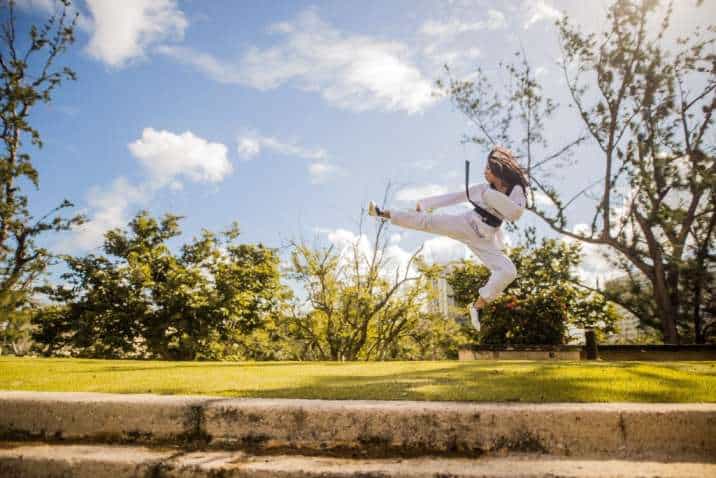
Yeah. Another thing that I learned that stuck with me from your training in 2012 was I’d never heard the term “asocial” before at the time. I don’t think I had, but I’m certainly aware of the term “anti-social.” And having that distinction that you’re looking for asocial people who could become or who are already a threat to you and recognizing that they’re asocial so that you can injure them before they hurt you, or kill you. And that was illuminating for me, just knowing what to look for. And maybe you could describe that in more detail for our audience.

Most of us, when we equate violence or aggression or anything, what we’re talking about is antisocial aggression. Antisocial aggression is communication, albeit very unpleasant communication. You can have a knife to your neck, but the criminal is talking to you. That is categorized as antisocial aggression. Asocial violence is devoid of communication. It’s just pure action, meaning they’re not trying to look at you, they’re not trying to communicate with you, they’re just trying to end you. And it’s a very different thing. So when I had you guys training, you’ll notice, I was adamant about not talking. I was adamant about being very quiet when you went in. It’s hard for people, especially a group like Tony’s group because everybody knows everybody and it’s such a positive environment. But keeping an asocial training environment, where you’re not communicating with the other person, and you’re not trying to do anything other than just really, you’re looking at the human body almost in a very laboratory, scientific type manner. And you’re just learning where on the human body to put your efforts to make sure that you get the person injured. What’s interesting is when that’s what people come to me and say, like a lot of the things I get from people when they take themselves out of situations, are they recognized asocial. They recognize all of a sudden, “Oh, wait a minute, there’s no communication going on here. This person is planning on doing something,” and they still have time to exit and get out of there. And that’s the big thing.
One story I talk about is my friend’s wife. She’d been through a little bit of training, and she was going to graduate school. They had studied late, it’s about ten-fifteen at night, and they’re walking to the parking lot. She had parked on the third floor. Her friends had parked on the first floor of the parking structure. As they’re walking in, she sees out of her corner-eye, a sketchy looking guy walking around that’s at UCSD in San Diego. And I remember she felt guilty. She thought she was judging the guy. She just dismissed it out of her mind, and she’s like, “I shouldn’t be so judgmental.” And her friends say to her, “Hey, we’ll run you up to your car.” She says, “No, no, no, no problem. I’ll just grab the elevator, and I’ll go up.” And she talked them out of it. So they take off, she gets in the elevator.
Asocial violence is devoid of communication.
She goes up to the third floor, the elevator door opens. He’s right there. That guy that she saw is right there in her face. She had a briefcase. And she said the first thing that popped out to her was just taking the briefcase, and it’s a hard briefcase, she just slammed it right into this guy’s groin. And then she balled up her fist on the side, and she hit him to the side of the head, which he then hit the door jamb, the solid door jamb of the elevator. And the guy dropped, he knocked out, and she ran to her car, got in her car and got away. Whatever happened to the guy? We don’t know. By the time security got there, he was already gone. Was it a mistake? Was this guy not an attacker? We don’t know that either. She recognized asocial.
And as my friend tells me, “Hey, my wife is still alive. My son still has a mom. That’s all I care about.” This guy, if he just made a socially awkward move, he made a huge mistake because, to her, she’s a small woman. And that was very threatening to her. Now what was great was she had enough training to be able to use that and survive. She goes, “You know what? I had all these non-verbal warnings that I ignored because I thought I was judgmental.” And she said, “I didn’t want to put my friends out.” There’s this thing especially it happens more so with women than men, where they feel like, “Oh, I shouldn’t react this way. I should be more accepting of people.” And “Oh, maybe they don’t mean that.” And the one thing is we’ve evolved as humans, to where right now we’re very reliant on traditional communication. You hear me talking, going back and forth. But for thousands of years, we had a lot more nonverbal communication going on in our bodies, and that stuff is still hardwired in us, and we need to just pay attention to it. And we are hardwired to recognize asocial, and, if you just think about it, Stephan, the only thing that means is all of a sudden, there’s no communication going on. And then the purpose is maybe aggressively moving towards you, or something’s happening, and you just get everything screaming in your body, “Hey, something’s about to happen.” And that’s that feeling of asocial.
We are hardwired to recognize asocial.
The number one thing that clients come back to me, and so funny that you pointed it out. They say that is by far the most profound thing they learned in the training and the most used information from the training. Because they can use it without incident many times to protect themselves, they’re able to just take themselves out, like, I don’t even think twice. If I feel weird about a situation, even though I’m highly trained, I’m very good at what I do. But I have no intention to willingly put myself in a situation where I might have to use that information. Because I realized that I’m just as easy to be injured as I am to injure somebody else. I have no special abilities to avoid any of the same injuries that I can put on somebody, and I’m just as successful. I tell people all the time, in my 30 plus years of doing this, and as a master close combat instructor, if I walk out the door and catch a pipe to the back of the head, I go down just like everybody else. But I’m okay. I’ve made that understanding that, yes, I’m vulnerable to all this. And therefore, my focus needs to be on what I can control and what I can control with my response to a threat. And that’s really how I do it.
Once you understand how the body reacts to trauma, you realize what makes a human so dangerous is their brain. Share on XBut what’s funny is the people sometimes, especially people that have not trained, sometimes they have this idea that “Oh if I start training, I’m going to become violent. And I’m going to want to karmically bring this into my life.” And that’s ridiculous. I mean, as far as the karma situation, as soon as people told me that, I said, “Hey, do you have a fire extinguisher in your kitchen? Because most codes say, you need to have a fire extinguisher in your kitchen.” “Yeah. I have that.” “You know how to use it?” “Oh, yeah.” “Oh, so you want a fire? You want a fire to come to your place?” Just because you learn to use the tool of violence to protect yourself, it’s the same thing as understanding how to use that fire extinguisher, you hope to never have to use it, but you certainly want to know how to use it if you ever need it. And so that’s how I go about trying to educate people on why it’s worthwhile to know this. Not to turn into a super ninja and not to do anything. But if you understand violence, and you understand how the human body responds to trauma, it takes away a lot of the irrational fears that you have.
You hope never to use violence for self-defense, but you certainly want to know how to use it if you ever need it.
It’s the same thing, and I’ll take people with firearms training, and especially people that are very hesitant to learn or scared of firearms. I don’t do it from the idea of, and I want to turn you into somebody carrying a firearm. What I want to do is I want you to understand how they operate, let you operate them safely, and then the irrational fear of the tool goes away, you realize, “Okay, not for me, but I know what this thing does. And I’m not going to have this irrational fear about this or give it any more power than it has. I understand that very powerful tool, if how to use it correctly. And it can be a great self-defense tool. But just like anything else, if I don’t put the time into it, and put a little study behind it, it could be detrimental too rather than helpful.” Whereas learning the principles of self-protection, as we put it out, I think sticks with people. Just the fact that you’re talking about the fact that you took in 2012, and you’re able to. You and I did not talk about this prior. You just started rambling off all the different things that were covered during that time. It was impressive.
When you were talking about the gun thing just a minute ago, I just remembered how you taught me to sit down if I’m holding a gun and somebody is trying to grab it from me. I just go like I’m sitting down, and it ends up gravity or like, science, whatever, I don’t know, moves the gun right directly into their chest. And I’m using gravity in my favor, and I don’t have to use a lot of muscles to direct the gun right back at them. So I just thought of that as you were talking. I don’t have any occasion to use it. I haven’t used that practice, that technique, and eight years and yet boom, there it was.
Yeah. And that’s the push-pull principle that we talked about, and that’s literally what got this type of training originally into the SEAL teams. This is what got the original program, and they answer the question having to do with a firearms situation like you’re talking about. And that’s what was taught. There was a SEALs Team 6. Back then, it was a counter-terrorist team, and they had done a ship boarding and the lineup. You’ve all seen it like when those special operations teams, line up outside a door and they all go in. Well, the second guy is going in, got held up by a bad guy. The first guys in there are fighting for his life, the rest of the guys can’t get through because the doors jammed with the sky. The instructor that I found that brought in, that was the first thing that he did. They had not been able to solve this thing at that point in six years. He didn’t even hear the whole thing before he took every one of these–and I told you I work with all the legends of the SEAL team. He’d like these guys up just in there, and they replicated the whole thing. The second guy gets caught, and he did exactly what you just said. He goes, “Hey, sit down,” the guy sits down, pulls the guy away from the door, pulls the gun center line so he can take care of the bad guy. And the rest of the guys got in right away. That’s when they were sold. That’s when they said we need to learn this type of training because these principles are not about punching and kicking. It’s about how to use the tool of violence, whether you have a tool like a gun or don’t have a tool like a gun. The principles are there. And that just shows me that it works.
As long as you do self-defense training and go through the methods and principles, they’ll be there for you.
The methodologies that I used in your class, and I’m always worried about Tony’s classes, because they’re usually huge, they’re big. The last one I did was like 400 people there. But we’re able to get the message across, and we’re able to do all of this. And to have you just tell me, like, literally while we’re talking, just coupled with another principle or method that we did. It shows me that, yeah, the training methodology is valid because it sticks with people. Because you do not have to memorize a set of moves, you understand a principle. You’re saying, “Oh, wait a minute, if somebody grabs something, and if I pull back, it’ll pull the centerline every time.” And just a simple method like that is just retaining. What’s so interesting, and I tell people this all the time, it’s kind of, we’re doing it differently. But I tell people don’t worry about memorizing this stuff. I said, it’s all kind of being taken care of for you, as long as you do the training, and you can go through the methods and principles, they’ll be there for you. And what proves to me that is the situation. Just now, you and I are talking, and then all sudden, something triggers, and it just comes back to you. The brain will look for the most effective information it has when it’s under threat. And that’s what will start popping up. And so that’s where this stuff comes back to people years later, even though they haven’t trained it.
Yeah, amazing. It’s like muscle memory. It’s just right there, latent, dormant, and ready to use. Of course, it probably helps to do follow-up training maybe years down the line.
Yeah, listen, if you want to be proficient at this, or you want to instruct it, or you want to shirt, the more you train, the more comfortable you are. But what’s interesting is the majority of situations that people find themselves in don’t require years and years of training. I tell people this all the time, the difference between becoming a combat sports athlete and just painting those types of events, and learning self-protection, to protect yourself from criminal violence is very different. The first one is the equivalent of me bringing in like a four-foot by ten-foot slab of marble that I bring in, and I bring in the finest artists and tools for making a sculpture, and I throw it down in front of the class, and I tell everybody, “Okay, guys. Nobody leaves here until I see a perfect replica of Michelangelo’s David. I think everybody probably is there for a thousand years, good luck. I mean, just the ability for them to come up with something like that is the same way of taking, say, a thousand people and putting them through combat sports, and then maybe one of those thousand will ever be a competitor of any level like a top 10 competitor. It’s a very rare small portion of people that can come top competitors.
Learning self-defense techniques is one thing, and learning the right approach for specific situations is another. Share on XBut if I took that same slab of marble, the same group of people in the room and brought in a bunch of sledgehammers, and said to them, “Hey, guys, I don’t care how you do it. But until I see a pile of rubble, nobody gets lunch,” you guys would figure out real fast how to just take that, put a little effort into it and no doubt that marble would be a pile of rubble. Because destruction is a very easy skill set. Becoming a high-level athlete, combat sports athlete, and taking up the direct injury to the human body, means you have to become very skilled at what you do and very athletic. And it’s skill versus skill, and it’s high years of training and amazing to watch when you see it in action. But what’s great is the skill set to have destruction is available to everybody, as long as you can think and move. The oldest guy so far that have used this information was 81. And the teenager that came at him, the guy was like, 18, just a street thug. If you saw them side by side, there’s no competition, and it would have been ugly. But because the teenager didn’t fear the man. And this man knew how to protect himself. He understood, “Okay, this is available to me.” And he was able to do a shin kick to the groin first. And then he did two other strikes, and just caught the kid off guard and knocked him out, and was able to save his own life against an armed assailant. But that’s only because he understood the situation, and he didn’t have to do anything beyond his abilities. It was a very simple strike that he did, but he knew how to do it. He also understood, they had to put everything into it.
At the very beginning, you want to lay this foundation of accuracy and correctness, just like firearms training.
And you go slow and smooth with people at first, so you understand accuracy and correctness on your hard and fast. I line up a bunch of striking bags. And I say, “Hey, go hit and kick those things as hard and fast as you can, whatever your hard and fast as you have it.” What I want to do is make sure that whatever effort you put in goes into a specific area that’s going to get you a big result. And that’s why you need to slow down and learn your targeting and understand where on the human body to put all that effort on, and I’m not worried about whether you’ll be able to go full speed or not. Because in the end, you can ramp it up. But at the very beginning, you want to lay this foundation of accuracy and correctness, just like firearms training. There’s nothing more chaotic than being in a firefight, yet they train very slow and deliberate in firearms. That’s the same thing I do because we’re learning a lethal application to protect ourselves using our brain and our body. And it’s the same thing, and I want you to go slow and methodical and be accurate and correct first before we add speed. And so that’s the idea behind it because the brain doesn’t know the difference between fast and slow. The brain is just saying, “What do you want me to do? Where do you want me to take your body? Where should I be when I need to use this information?” And you’re saying, “Okay, ultimately, I want to be here, I want this one square inch of me on that one square inch of him,” and your brain is processing all of that. And that’s the methodology that you guys learned when we were doing our training over the days that we’re doing it in Cabo.
Yeah. Amazing stuff. I know, we’re out of time. So let’s tell our listeners where to go to learn more. I know you have some free information that I think is maybe an ebook form that we can send folks to read and access. What’s their next step?
Yeah, if you just go to the website, SurviveViolence.com, put your email in, you’ll not only get a book, there’s also a course that you’ll get for free. If you enjoyed the information that you and I talked about during this podcast, then you’ll get a lot more of the same in that area. And again, I like people to understand, of course, I’d love everybody to be a client. But I’d like to give out a lot of information to make sure that my methods or principles are right for you. And I think if you go to Survive violence, you’ll get a lot of free material that’ll help you determine if it’s for you.
Yeah, and that’s very generous of you, and I’m sure you’re saving some lives who you won’t even know who they are or that they even consumed your information. They were never clients, but you’re saving lives probably all the time.
Oh, thank you. Yeah, it’s rewarding. Oh, hopefully, we’ll have too much of your editing all wonky. Okay. Sure.
Thank you so much, Tim. And listeners, please take this seriously. Think of somebody who could benefit from this besides yourself. So you got some homework for yourself. But then share this with others so that they can save themselves or save others as well.

